The Ultimate Guide to Swimming on Maui

Where to go, what to see, and how to make the most of swimming on Maui
Maui is one of those places that seems to have it all – lush valleys, volcanic peaks, cascading waterfalls, and some of the best beaches in the world. And while each Hawaiian island has its charms, Maui stands out for one thing in particular: no matter where you go, you’re never far from a beautiful beach: there’s truly nothing like swimming on Maui.
It’s the reason we always come back to Maui when we need a warm, water-filled retreat.
Golden sand, calm bays, family-friendly shorelines, world-class snorkeling, and even a few unique black-sand stretches make Maui a true swimming paradise. Whether you’re planning a full beach day, sneaking in a morning swim before exploring the island, or snorkeling along colorful reefs, this guide covers everything you need to know about swimming on Maui.
Why We Love Swimming on Maui
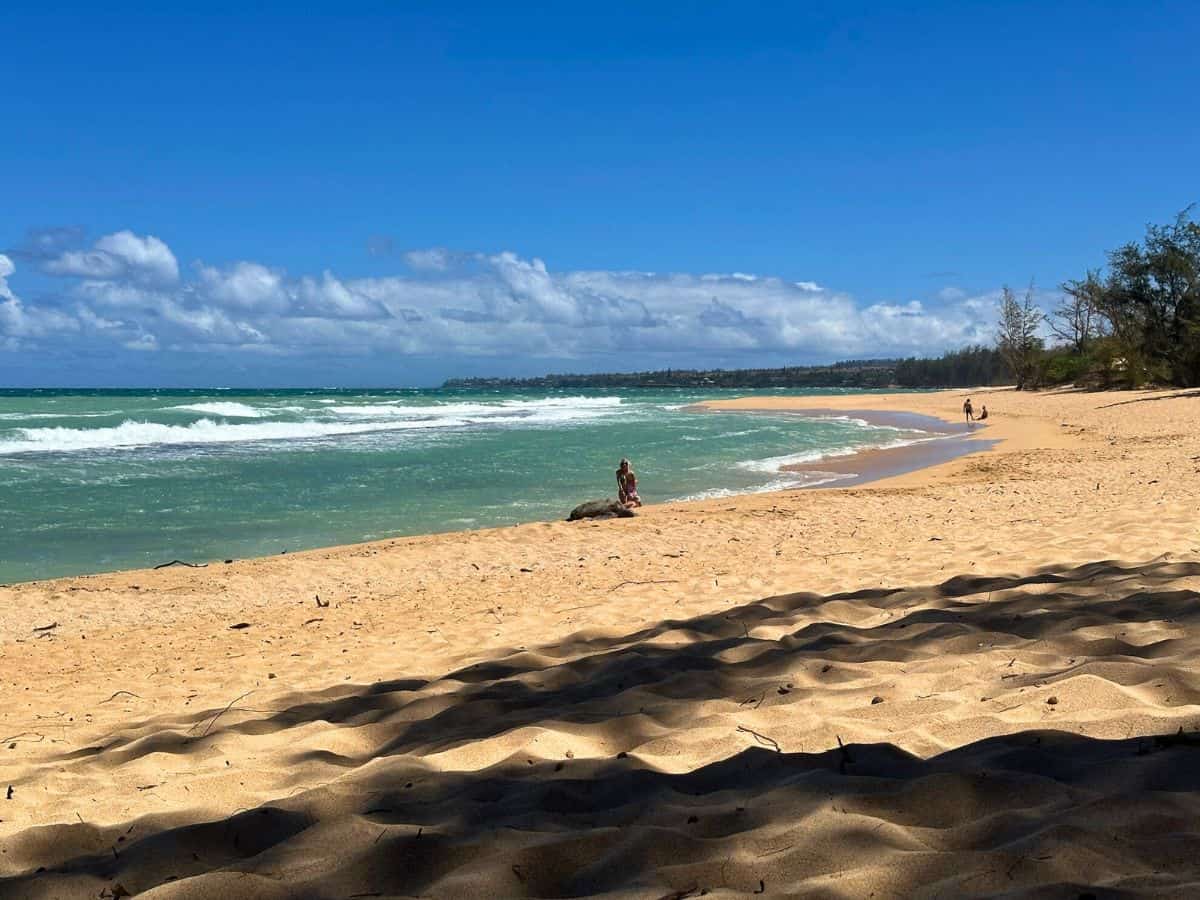
Unlike places with rocky or pebbly coastlines, Maui beaches are generally soft, golden sand. The island is famous for its swimmable shores – calm enough for families but still exciting for adventurers. Many beaches double as snorkeling spots, with reefs and fish often just steps from the shoreline.
Compared to other Hawaiian islands, Maui is particularly known for having more swimming-friendly beaches. You don’t need to be an expert at reading surf forecasts or hiking into hidden coves to find a good place to swim. From north to south, west to east, Maui’s coastline offers a long list of excellent beach choices.
Water Temperatures and Conditions
One of the best parts about swimming on Maui is that the ocean is warm enough year-round.
- Winter (Dec–Mar): Average ~75-76°F (24°C). This is as cool as it gets, but still plenty warm for swimming.
- Spring (Apr–May): ~76-78°F (24–25.5°C). Increasingly pleasant.
- Summer (Jun–Aug): ~78-80°F (25.5–26.5°C). Ideal for long swims and snorkeling.
- Fall (Sep–Oct): ~80-81°F (26.5–27°C). Warmest water of the year.
Unlike many other beach or island destinations, you don’t really need to worry about “cold water” seasons on Maui. The main difference is that the north shore tends to be rougher in winter due to big surf, while the south and west sides usually stay calmer.
We’ve found it really helpful to check water conditions each morning before heading out, as they can easily influence your beach choice for the day. Many local snorkeling gear shops post daily condition reports – we especially love The Snorkel Store’s updates.
It’s also worth tuning in to a local weather report each day to stay on top of any disturbances or swells that could create larger waves or unsafe swimming conditions.
Best Months for Swimming on Maui
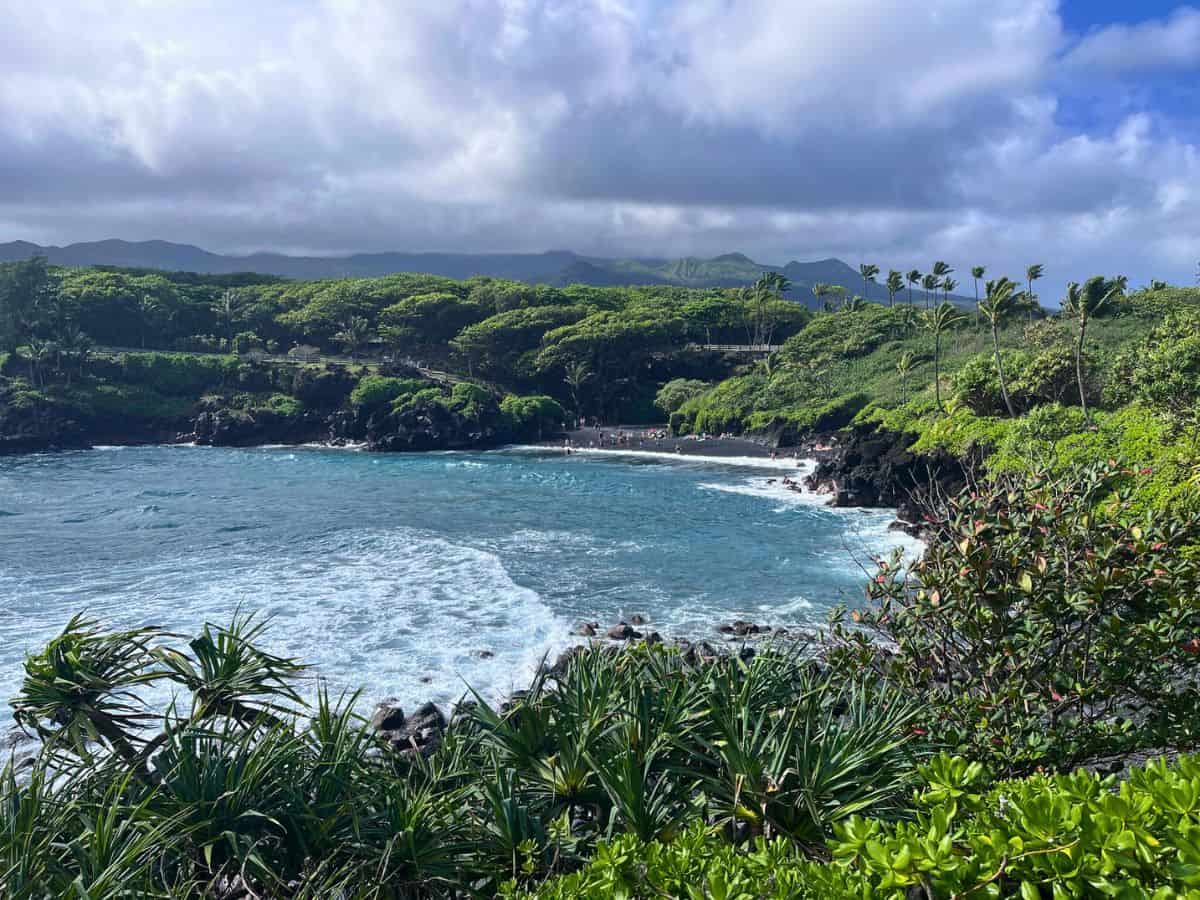
Because the water stays relatively warm on Maui year-round, there’s really no bad month for swimming on the island. But each season brings something unique:
- December to April: Cooler water, but it’s whale season! You can often spot humpbacks breaching just offshore while you swim or relax on the beach.
- May to September: Warmest water, calmer conditions, and excellent snorkeling visibility.
- October and November: Shoulder season – warm water, fewer crowds.
If we had to pick, late summer and early fall are best for swimming conditions, while winter wins for sheer magic (because of the whales). That said, we’ve visited Maui every season of the year and have always had a great time in the water.
Safety Considerations
The ocean in Hawaii is powerful, even when it looks calm. Keep these tips in mind:
- Box jellyfish: These occasionally show up, more commonly on Oʻahu, but worth noting. The Waikīkī Aquarium maintains a calendar of likely arrival dates.
- Rip currents: Heed lifeguard warnings and signage. Never swim where conditions look dangerous.
- Surf: North shore winter swells can be enormous – great for watching surfers, not safe for swimming.
- Sharks: Sightings are uncommon, and attacks are very rare. Avoid swimming at dawn, dusk, or in murky water, and stay away from fishing areas to minimize risk.
Lifeguarded Beaches on Maui

If you’re a cautious swimmer (or traveling with kids), heading to a lifeguarded beach is a smart choice. Not only are there trained eyes on the water, but lifeguards also post daily conditions so you know when it’s safe. And if you’re unsure, never hesitate to ask a lifeguard about beach conditions.
Our favorite lifeguarded beaches for swimming on Maui include Baldwin Beach Park (North Maui), D.T. Fleming Beach Park (West Maui), and Kamaole I, II, and III in Kihei (South Maui).
Lifeguard hours vary by season. Outside of lifeguard hours, conditions are “swim at your own risk.” For more information, visit Maui Ocean Safety.
What to Look for in (or near) the Water
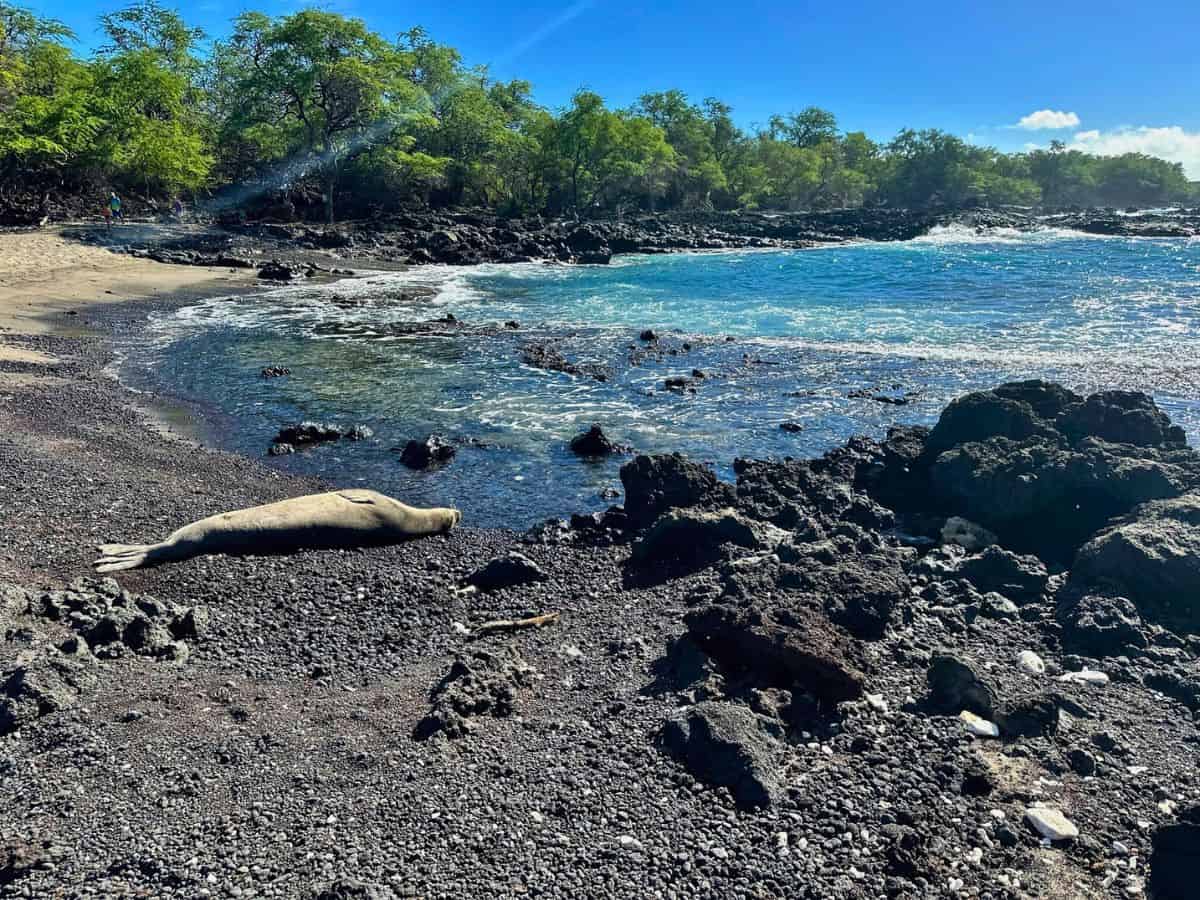
One of the best parts of swimming on Maui is discovering how alive the water feels. Even in shallow areas, you’ll often spot flashes of color or movement beneath the surface. Back on land, keep an eye out for whales, dolphins, and even seals.
- Sea Turtles (Honu): Green sea turtles are common around Maui and are always a thrill to see. You might spot them gliding by while snorkeling or resting on the sand, especially along the north and west shores. Remember to keep a respectful distance and never touch or chase them – it’s both harmful and illegal.
- Hawaiian Reef Fish: You’ll see dozens of bright tropical fish swimming through the coral, from yellow tangs to butterflyfish and parrotfish. Keep an eye out for the humuhumunukunukuāpuaʻa – Hawaii’s state fish – recognizable by its colorful markings.
- Eels and Other Surprises: Sometimes you’ll glimpse a moray eel peeking from a rocky crevice or a trumpetfish drifting vertically among the coral. They can look intimidating, but they’re generally shy and safe to observe from a distance.
- Whales (winter months): If you’re visiting between December and April, you’re in for a treat – this is humpback whale season. While you won’t see them up close in the water (and swimming with them is prohibited), you can often spot their spouts or tails offshore.
- Dolphins: Spinner dolphins sometimes pass by offshore, especially around West Maui. While you shouldn’t approach or attempt to swim with them, it’s pure joy to catch a glimpse of them leaping or spinning in the distance.
- Hawaiian monk seals: Rare and protected, these endemic seals sometimes haul out on beaches to sunbathe. Keep your distance and admire quietly – it’s a magical wildlife encounter!
Our Favorite Beaches for Swimming on Maui
Now for the fun part – where to actually dive in! Maui has so many wonderful beaches, you really can’t go wrong in swimming on Maui. But after several visits to the Valley Isle over the years, the following beaches stand out as our favorites.
We’ve organized our favorite beaches for swimming on Maui by island location. Know that the beaches of West and South Maui are generally calmer than those on East and North Maui. Still, those on the East and North shores can be great for beach strolls and dipping your toes in the water and, on calmer days, actually getting in.
North Maui

Wilder and less developed, North Maui’s beaches – near laid-back Pāʻia and the surrounding coastline – draw locals, surfers, and travelers seeking dramatic scenery. It’s also one of the best areas to spot sea turtles gliding close to shore. Conditions can be rougher here, especially in winter, but the scenery makes it worth exploring on calmer days.
- Baldwin Beach Park: A long, sandy stretch popular with locals, with lifeguards on duty. Waves can get larger in winter.
- Baby Beach (Pāʻia): Right next to Baldwin, this calm lagoon is sheltered by a natural rock wall – great for families or anyone wanting a relaxed swim. Bonus: we’ve spotted sea turtles here on every visit.
- Ho‘okipa Beach Park: Known for its sea turtles and surf culture. This is one of Maui’s top turtle basking spots, though waves can be strong – better for watching than swimming.
South Maui

Home to Kīhei and Wailea, South Maui enjoys sunny, sheltered conditions that make swimming and snorkeling a safe bet year-round. The beaches here range from lively family spots to quiet stretches perfect for an easy dip or sunset stroll.
- Kama‘ole I, II & III: Three connected beaches with lifeguards, restrooms, and showers. Calm water, gentle entry, and a great family vibe. Kama‘ole III has a big grassy park perfect for picnics.
- Ulua Beach: One of our favorites in Wailea. Calm water, great snorkeling near the rocky edges, and soft sand.
- Wailea Beach & Polo Beach: Both are excellent choices, often fronting resorts but fully open to the public (like all Hawaii beaches).
- Makena (Big Beach, Makena State Park): Golden sand and backed by volcanic hills, Makena is one of Maui’s most striking beaches. Great for swimming on calm days, but waves can be powerful – heed lifeguard warnings.
Where to Stay Nearby: In Kihei, the Maui Coast Hotel is a a great option just across from Kama‘ole I, and walkable to many local eateries.
East Maui

Remote, lush, and dramatic, East Maui – anchored by the small town of Hāna – feels like another world. Many beaches here make great stops along the Road to Hāna, offering black-sand coves, waterfalls, and a sense of true adventure.
- Waiʻānapanapa State Park (Black Sand Beach): Famous for its dramatic volcanic shoreline. The sand is jet black, the waves can be rough, and swimming isn’t always possible – but it’s worth a stop if you’re driving the Road to Hana. Reservations are required; book online before you go.
- Hāna Bay Beach Park: A small, calm beach right in Hāna. Great for a quick dip if you’re exploring the town, though it’s more low-key than other Maui beaches.
- Kaihalulu Red Sand Beach: Just past Hāna, this secluded beach has striking reddish sand and turquoise water. Access requires a short hike, but it’s a great off-the-beaten-path spot. Swimming is possible but waves and currents can be unpredictable – approach with caution, and consider just observing from the shore.
West Maui
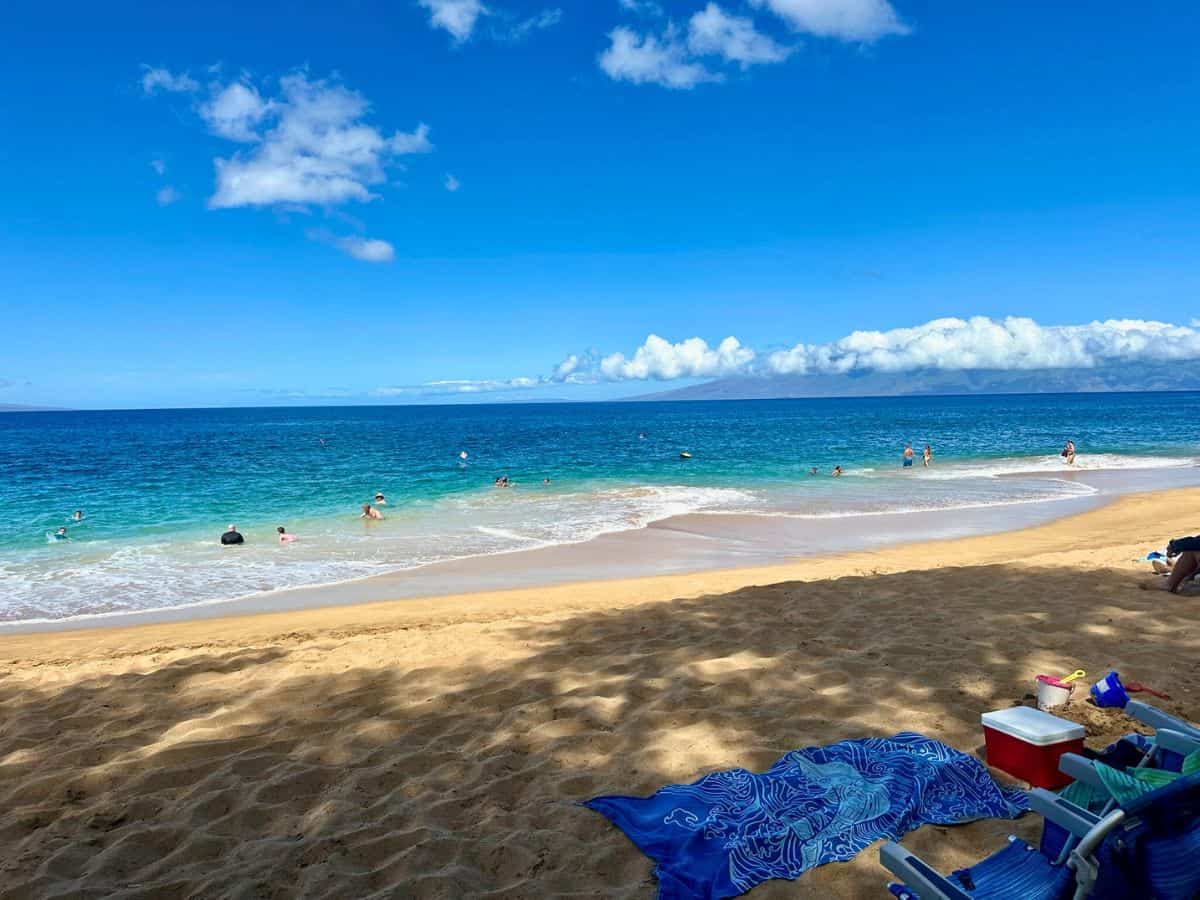
Centered around Kāʻanapali, Lāhainā, and Napili, West Maui is where clear, calm waters meet golden sand – ideal for swimming, snorkeling, and long, lazy afternoons. With views of Molokaʻi and Lānaʻi islands across the channel, this area blends resort ease with classic Hawaiian beauty. There’s a reason we list so many beaches here – it’s one of the best spots for swimming in Maui!
- Olowalu Beach: Just off Honoapi‘ilani Highway (30) between Ma‘alaea and Lāhainā, Olowalu is known for easy off-the-beach snorkeling and shallow reefs full of tropical fish. Watch your step around coral.
- Kāʻanapali Beach & Black Rock: Iconic, long, swimmable stretch with great snorkeling around Black Rock – keep an eye out for fish and turtles.
- Kāhekili Beach Park (Airport Beach): Less crowded than Kāʻanapali but still fantastic for snorkeling. In winter, we’ve even spotted dolphins offshore.
- Napili Bay & Kapalua Bay: Picture-perfect crescent beaches with calm waters and easy entry – great for snorkeling and paddle boarding.
- Honolua Bay: A short walk from the road leads to one of Maui’s best snorkeling spots. The entry is rocky (water shoes help), but underwater life is incredible.
- D.T. Fleming Beach Park: Quieter vibe with lifeguards and restrooms. Surf can be stronger, but summer conditions are often good for swimming.
Where to Stay Nearby: If West Maui feels like your ideal base, consider the Outrigger Kāʻanapali Beach Resort – just below Black Rock, offering easy access to snorkeling, swimming, and gorgeous sunsets.
Frequently Asked Questions
Do you need water shoes?
Not usually. Most Maui beaches are soft sand. But rocky entries like Honolua Bay are easier with reef shoes or fins. We love these water shoes – affordable but super grippy.
Are there changing facilities or showers?
Yes, typically at lifeguarded beaches (Kama‘ole, Fleming, Baldwin, etc.). Remote beaches may not have amenities.
Is it safe to swim everywhere?
All the beaches in this post can be safe to swim at, but conditions vary. South and west coasts are calmer, while the north shore has big surf in winter. Always check warnings.
Do you need a car to get to Maui’s beaches?
Technically, no – Maui has a public bus system. However, it’s easiest to navigate the island with a car, especially if you like to beach hop.
Will I see turtles?
There’s a good chance! Common turtle hangouts are at beaches along the North and West Maui shores. Just remember: admire from a distance, and never touch the turtles.
What should I pack for a day at the beach?
For a fun and safe day on Maui’s beaches, bring reef-safe sunscreen (Hawaii bans certain chemicals), a rash guard for extra sun protection, snorkel gear if you plan to explore underwater (goggles work too for swimmers on a budget). Many beaches and hotels offer chairs and umbrellas, but you can rent them if needed. Don’t forget plenty of water and snacks, as not all beaches have facilities nearby.
Final Thoughts: Swimming on Maui
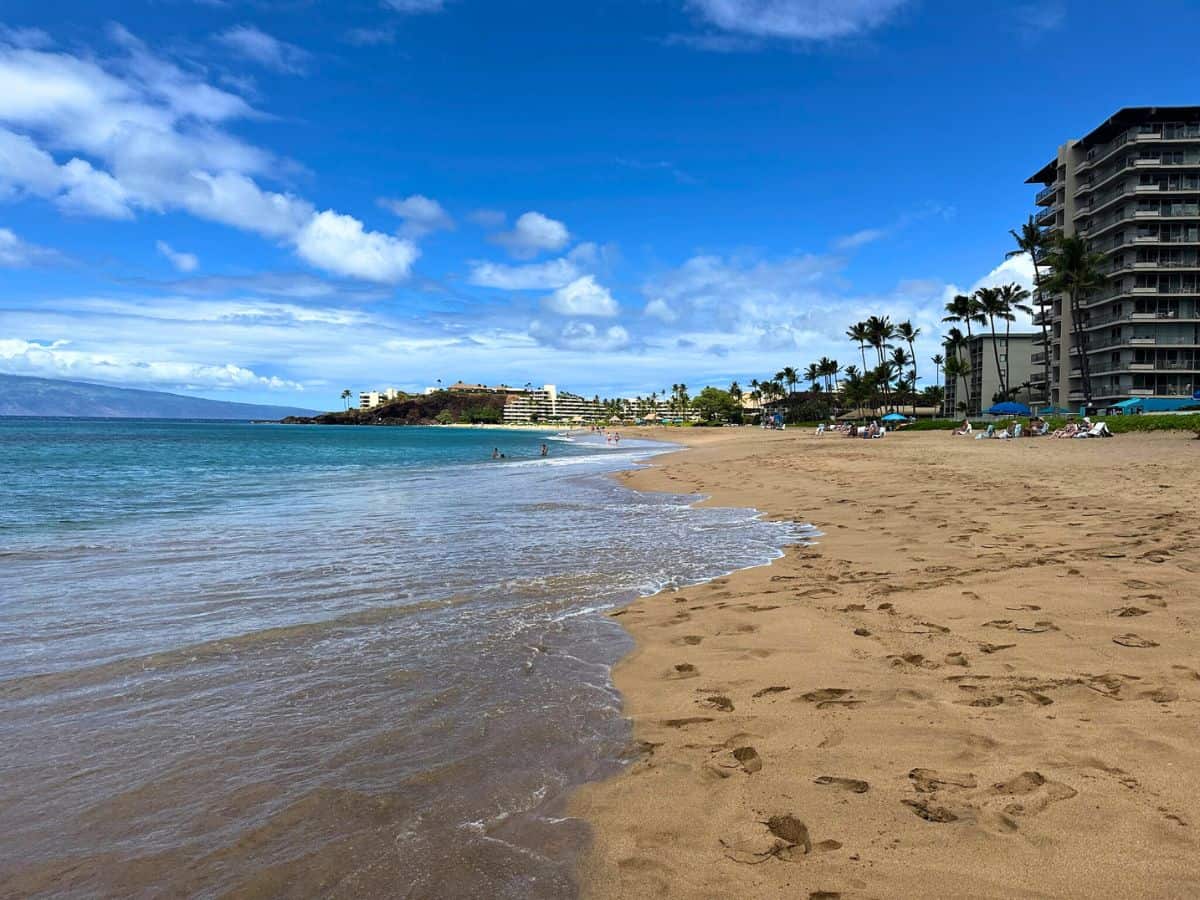
Swimming on Maui is one of the simplest pleasures of visiting the Valley Isle. Whether you’re floating at a calm beach, snorkeling alongside tropical fish, or spotting whales breaching on the horizon, Maui beaches deliver unforgettable experiences.
The best part? There’s no single “right beach.” Wherever you go on Maui, chances are good you’ll find an excellent beach just minutes away. So pack your rash guard, throw on your snorkel mask, and dive into the warm waters of the Valley Isle.
